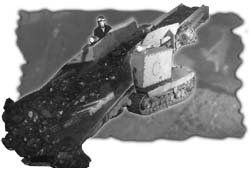



    |
|
|
Haulage Richard Brown, G.M.A. engineer in 1826, tells of crude methods used in a Sydney "main" first opened in 1785. As workings advanced from the shore in a westerly direction, new shafts were sunk at intervals of about 200 yards so that the length of haulage from the faces of the bords to the bottom of the shaft never exceeded that distance. Brown also said that coal was hauled in two-bushel tubs on small iron-shod sledges, over a roadway formed of round poles, two to three inches in diameter, laid transversely. After 1827, steam hoisting engines were installed and used in the movement of coal in the mines, according to author, C. Gerow. 
Early history tells us that, to move materials into the mine and to remove coal, rails were laid from the elope shaft bottom to the working areas of the mine. Horses or "pit ponies" were first used for this haulage. During and following the First World War, underground mechanical haulage began to replace the horses and gravity balance systems in the mines of Pictou County. It was also in that area, sometime around 1890-1900 that air-driven machines were installed. In some of the working areas of the old mines, a system of overhead pulleys and cables pulled materials in coal boxes along the rails to workplaces where horses or 'balance systems' took over. In the early 1920s small air or electric hoisting engines began to replace horses in the balances and sinkings, and in due course gradually took over from "horse draft." In a report dated June 1925, author J.R. Dinn talked of underground haulage in Cape Breton Mines... it was necessary to haul coal either by horses or by pushing it to the headway which was driven to the dip and rise. The cars were gathered by an electric or air hoist and lowered on a headway (a passage connecting other passages), to a level road, from which point they are hauled by main and tail, or by single-rope engines to the landing at the main deep. From this point, they were transferred to an endless system which delivered coal to the shaft or bottom or tipple. Dinn noted four distinct operations in the movement of coal from the faces to the pit bottom: horse, single-rope, main and tail rope and endless rope. In 1948, mine cars were hauled at up to eight miles per hour by electric and diesel locomotives. |
|
The History |
The Future
Regional Impact | Mining Techniques | The Museum Main | Glossary | Site Map | Text Only |

Created by Virtual Media Productions Ltd., © 1997.
|